All you need to know about your products!

| 3DNews Vendor Reference English Resource - All you need to know about your products! |
||||||
 |
||||||
|
|
||||||
Chaintech 7600GS 512 MB – twice as much of video memory, performance - the sameAuthor:Date: 15/07/2006 Perhaps every video cards manufacturer has at least once thought of producing a video card with increased video memory capacity. Chaintech also took to this idea and today we are presenting you a product based on 7600GS with increased memory capacity. We already know through practice that increase in video memory capacity, especially in video cards of the mainstream sector, rarely bring pleasant surprises to the user. Normally, increase in the video memory capacity is accompanied by a drop in its operating frequency. A twofold increase in the memory capacity costs a certain amount and in order to proudly claim something like "our video card offers as much as 512 MB of memory" and save at the same time, manufacturers use a simple trick - memory production is going on, but the memory is cheap and thus slow. It turns out there is much memory, but no use of that. We observed a similar situation quite recently on the example of 7600GS with 512 MB memory capacity. In fact, all the above stated is not aimed at intimidating anybody and avert from 512 MB video cards for good. We mean we should take the "marketing allure" calmly and reasonably, as well as take a close look at not only the memory capacity but also a group of specifications which in the end determine the performance. Today, we will find out what Chaintech is offering with its "7600GS + 512 MB" label and compare the novelty versus the already tested Chaintech 7600GS 256 MB. But - all in good time. If you took a close look at the photo of the box from Chaintech 7600GS 512 MB, you might have got the questions - why does not the box say there is only 256 MB of video memory? There is no dirty trick about that - the card simply arrived at our test lab just made in this way. A comment from the employees of the Chaintech representation office said: - "the boxes of video cards will make no difference from one another but for the figure of the video memory capacity, the original packaging wasn't simply delivered in due time". Clearly, the reverse side of the package is exactly the same as for Chaintech 7600GS 256 MB. Kit of accessories:
Another look at the front side of the PCB once again convinces us that the PCBs of both Chaintech 7600GS video cards are identical. There arises the question - how did engineers at Chaintech manage to fit 512 MB onboard when even the 256 MB versions also used eight memory chips? At the same time, there aren't any memory chips on the reverse side of the PCB. The answer is quite simple. They used memory chips of double density, so the memory capacity has gone up twice as much with the same number of memory chips. 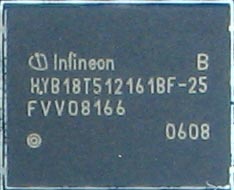 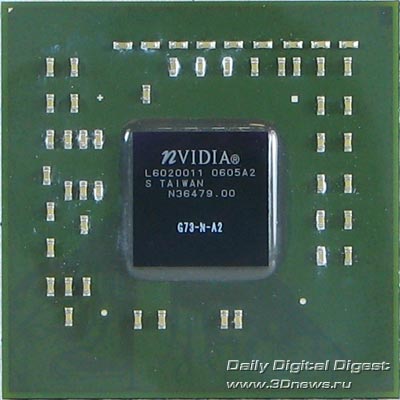 As regards the video processor, there are no surprises about it. We see the good old G73 chip of revision A2, like on any other 7600GS, and it also runs at 400 MHz. Well, it's about time we finish getting familiarized with the exterior of Chaintech 7600GS with 512 MB. As we see, there aren't any differences in the operating frequencies and design from the 256 MB version. At least, we can't expect a drop in performance, and tests will show how it rises with the increase in the memory capacity. OverclockingSince in terms of design the Chaintech 7600GS with 512 MB onboard does not make any difference from the 256 MB version, we did not expect any surprises from overclocking. Nevertheless, the card was running stably at 475/900 MHz for the GPU/memory, respectively. The result is absolutely identical to that produced through overclocking the typical 7600GS. We found not much sense in finding additional 4-5 MHz, and it is easier to compare results at equal frequencies of video cards differing in only the video memory capacity.BenchmarkingTest setup
To test the video cards, we used NVIDIA WHQL 84.21 drivers. During the tests, we compared the results of the novelty versus those for Chaintech 7600GS 256 MB running at the nominal frequencies 400/800 MHz, as well as after overclocking to 475/900 MHz. The results for the 256 MB video card are depicted in dark green, and those after overclocking - in light green. The results for the Chaintech 7600GS 512 MB video card are depicted in blue, and those after overclocking - in light blue. 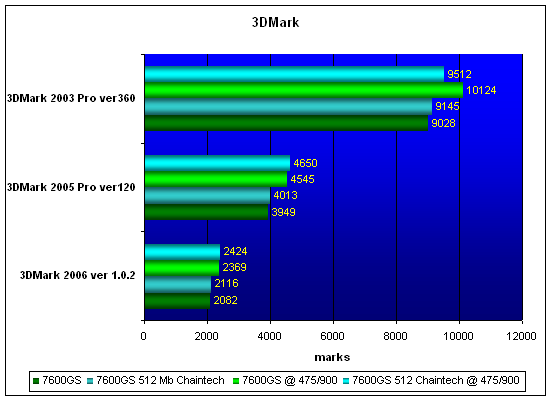 Our tests in the synthetic benchmarks showed that Chaintech 7600GS with 512 MB is albeit a bit but takes a lead over the 256 MB version. However, the boost is comparable to the measurement error and we can't call this a "revolution" at all. Moreover, at 3DMark'03 the regular 7600GS rushes forward for some unknown reasons. 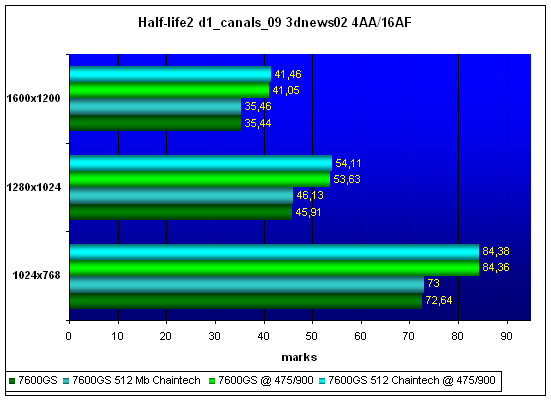 At Half-Life 2, the picture is not changing. With the frequencies being equal both in the nominal mode and overclocked, both the video cards run abreast, and the small advantage of the 512 MB version fits within 1%. 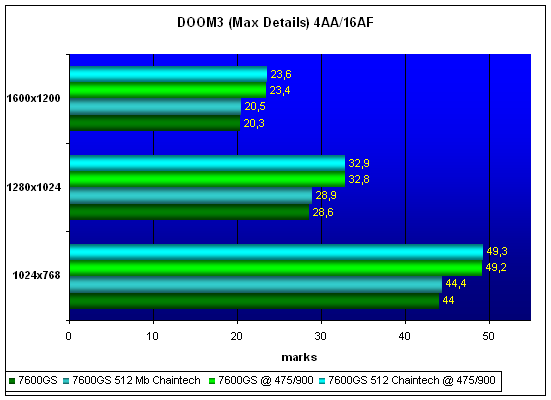 Did you expect to see something different in DOOM3? There is a equality of results and nothing more. 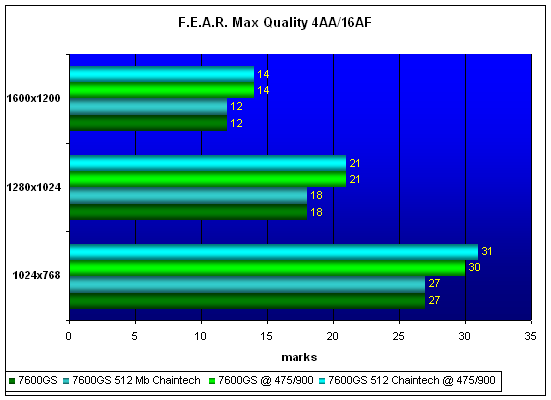 At F.E.A.R., the results are completely identical. Even in the most demanding mode where we hoped to see some advantage from the added memory capacity, there is no boost. Final WordsWell, what to say to that? At least, Chaintech 7600GS 512 MB has proved no worse than its 256 MB version. We thank Chaintech for that. But.. does it really make sense paying extra for additional memory capacity? In our view, it doesn't. With the equality of prices, the 512 MB makes sense to buy only for boasting among your friends, but you won't see any advantage in performance. On the whole, Chaintech 7600GS 512 MB is a good-quality 7600GS video card with quite regular specifications. |
|
|||||